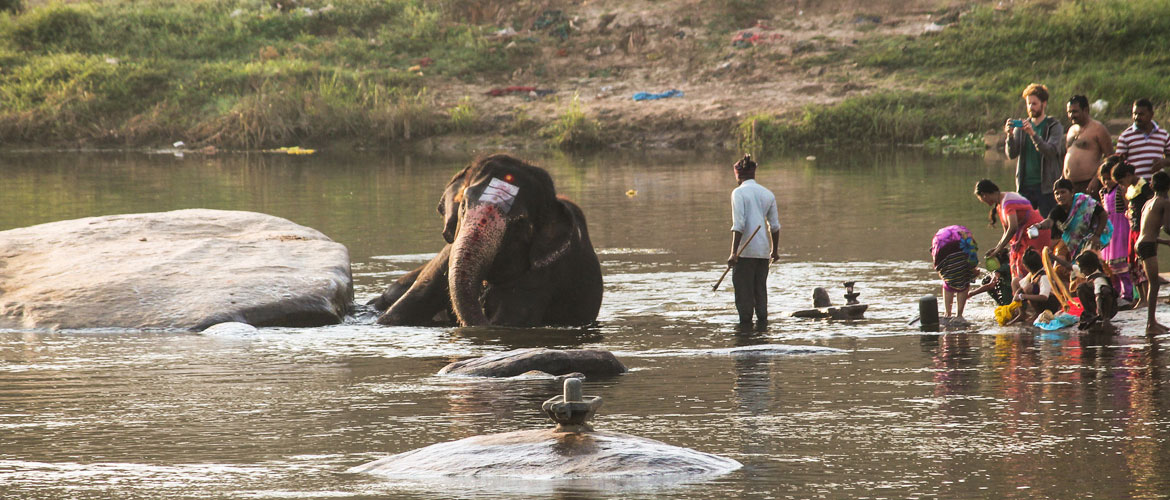Kingfishers flew across the Tungabhadra and perched on a telegraph line nearly as high as the tip

Lakshmi is the star-attraction of the Virupaksha Temple. I’d met her a few days earlier under not-so-happy circumstances inside the temple precincts, as she stood inside a pavilion clearly too small for her blessing a never-ending line of delighted devotees with her tired trunk. I watched her now as she made her way to the middle of the river with the mahout on her back. Hazy images of statues, carvings and temples whirled through my mind, eliciting memories of the past few days that I had spent in Hampi.

As I stood on the southeastern slope of the Hemkuta hill, scanning the giant statue of Sasivekalu Ganesha, my eyes settled on the snake carved around the distinctly over-indulged belly of the elephant god. The belly signified the Vijayanagara empire’s wealth and prosperity whereas the snake around it was probably meant to be a subtle reminder of the knowledge and wisdom that co-existed with it. The pavilion around the statue had been built much later, in 1505 CE, by a trader from Chandragiri, in modern Andhra Pradesh, in memory of Narasimha II of the Saluva dynasty.

Further up, to the north of the hill, I encountered a remarkable hall filled with pillars that stood out amongst the other structures. The long, svelte granite pillars of the hall were crawling with intricate carvings of Vishnu’s dashavatara. Inside this hall was another colossal monolithic sculpture of a rotund Kadalekalu Ganesha. The belly of this statue was chiselled to resemble a Bengal gram—hence the name, kadalekalu. As I made my way to the royal enclosure, I came across another elaborate structure with eleven beautifully carved domes. This used to house the Elephant Stables—a fine specimen of Indo-Islamic architecture and also a beautiful reminder of the harmony that existed in the cosmopolitan environs of the empire. Specially built for the royal elephants, under each of these domes was a chamber large enough to accommodate two elephants comfortably. Each chamber was connected to the adjoining one with an arched doorway big enough for a mahout to enter and exit. The ceiling of every chamber was meticulously carved with designs so beautiful that were I a royal elephant in those days I’d sure have developed an eye for art.

Abd-al-Razzaq, the Persian traveller who visited Vijayanagara in the 1440s, had recorded elaborate descriptions of these elephants. They were supposed to have been the largest of the thousands owned by the royal family. He even wrote of a magnificent white elephant which was led out before the monarch every morning as the sight of it was meant to be a happy omen. He described, in detail, how the royal elephants were fed khichri laden with butter twice a day and the punishments that the king meted out to mahouts for the smallest of mistakes. Razzaq also gave a detailed account of how elephants were captured and tamed to be drafted in the royal army.The Mahanavami Dibba, unlike other structures in Hampi, does not seem to be much of an architectural marvel from afar—just another platform, slightly taller than the rest—in the royal enclosure. But on closer inspection it proves you wrong. Covered from top to bottom with figures in carved in relief, the level of intricacy of the carvings that cover the platform is astounding. Musicians, dancing girls, hunters, traders, birds and the many elephants are so beautifully rendered that you can tell the exact expression on the face of even the smallest carving. This platform, a stunning specimen of the level of sophistication present in the craftsmanship of those days, was the centre of the Mahanavami festival, a major celebration throughout the empire. It was from here that the king and his court watched the proceedings of the three-day festival unfold and it is quite evident from the carvings on the base of the platform that elephants, again, were an indispensable part of the festivities.

Razzaq, in his memoirs, writes of a remarkable spectacle during the extravagant festival. In pursuance of the king’s orders, all the generals and other personages from all over the empire would gather at the palace, sometimes travelling for as long as three months, just to get here in time for the festival. With them they brought thousands of elephants, who were assembled in front of the castle, their curvaceous backs resembling the waves of a troubled sea. Covered in beautiful armour and decked up to their trunks in jewels of all colours, these majestic beasts carried on their backs make-shift castles, equally magnificently adorned. In them were placed jugglers, dancers and performers of all kinds.
The elephant, I realised, somehow stood out as a significant totemic symbol of this erstwhile empire whose beating heart lay right here, on the southern bank of the Tungabhadra. It was, in fact, the backbone of Vijayanagara’s flourishing culture, befittingly acknowledged in stone. As the rising sun reflected on the river, turning it tangerine, the sudden explosion of colours in the sky—pink, orange and golden—pulled me out of my reverie. The kingfishers flew off their line and disappeared behind the temple. I watched Lakshmi as she flung the stick-wielding mahout off her back, and plopped down in the river, soaking herself in the waters of the Tungabhadra, a melancholic metaphor of the glorious days that once were.
Elephant Stables
Ganesha temples
Hampi


